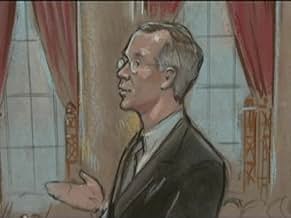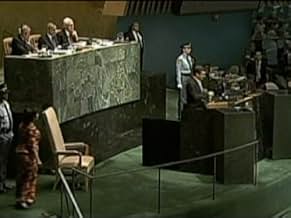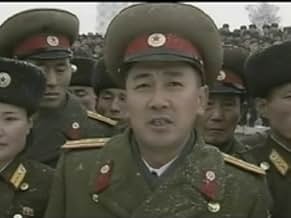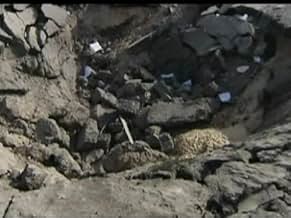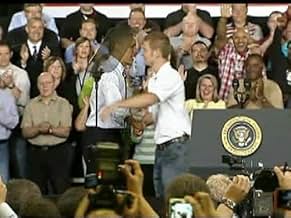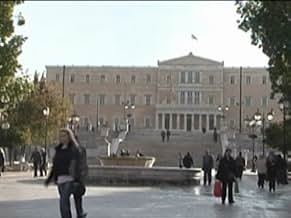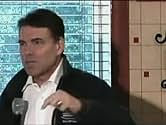Adicionar um enredo no seu idiomaPBS NewsHour is an news show which shows news updates.PBS NewsHour is an news show which shows news updates.PBS NewsHour is an news show which shows news updates.
- Ganhou 1 Primetime Emmy
- 14 vitórias e 22 indicações no total
Explorar episódios
Avaliações em destaque
The Public Broadcasting Service (PBS) program, PBS NewsHour, is arguably one of America's leading television news programs. Circumstances dictate, though, that few are aware of this. NewsHour does not warrant the intense spotlight as would a counterpart on a commercial station with greater resources.
It was named the "Robert MacNeil Report" upon its inception with founding co-anchors, Robert Breckenridge Ware MacNeil and James Charles Lehrer. Months later it became the "MacNeil/Lehrer Report". It would adopt its enduring moniker, "NewsHour", in 1983 when it became the "MacNeil/Lehrer NewsHour", and extended from 30 minutes to a full hour. After Robert MacNeil's retirement in 1995, it was titled the "NewsHour with Jim Lehrer" for fourteen subsequent years. Its current name was established in late 2009, as it underwent a considerable format alteration.
The "PBS NewsHour" encourages greater attention than conventional abrupt news reports. It is outstanding for its in-depth coverage of issues, including its presentation of opinions. The program encourages greater attention to stories beyond the rapidness of conventional TV journalism. The greater allotted time enables "NewsHour" correspondents room to give greater context to an issue or a news-maker. This approach of the "NewsHour" has earned complements by the political likes of John McCain, Al Gore, Richard Lugar and Tom Daschle. It is one of the reasons Jim Lehrer has been selected to moderate many Presidential Debates.
If the popular conclusion holds true, the harbinger of some of the early pressures on American public television—and the conception of the "NewsHour"—may have originated in the lead up to the 1960 Presidential Election. That conclusion being that it was the television debate which resulted in Richard Nixon's loss to John Kennedy; a setback which motivated Dwight Eisenhower's former Vice President to develop an interest in the still emerging television medium, and its role in politics. This interest was nurtured later when Nixon returned to public life on his way to winning the American Presidency in 1968.
There is another somewhat similar area of contention: contrary to the Carnegie Commission's intent that public television was to be independent of political influence, President Lyndon Johnson had other ideas that the system would serve as a limited political tool for his agendas. Whatever his plans might have been, however, Johnson's time as president was near its end after the system was established.
By the time President Nixon arrived in the White House, Robert MacNeil, previously a correspondent for NBC, had already soured on the American press because of the way he felt it covered the Vietnam War. It was a reportage he determined was too accepting of the optimistic assessments from officials within President Lyndon Johnson's administration. The war in Vietnam he came to oppose, and conveyed as such in an upstart subjective radio journalism format, which allowed analysis and editorials.
In the early 1970s, MacNeil temporarily left the British Broadcasting Corporation to work with American public television, hired by NPACT—National Public Affairs Center for Television. MacNeil was placed on-air with former NBC colleague, Sander Vanocur, to cover politics. When Vanocur left amidst political pressure fueled by the perception that he was a Kennedy supporter in a public television system viewed by some as anti-Nixon. Jim Lehrer was tasked to replace him. Choosing Lehrer was perceived as less contentious, due to his past with a top Republican and PBS executive that supported President Nixon.
Lehrer had begun work at PBS as an off-air program coordinator before joining MacNeil on air. After leaving newspaper reporting behind, his first forays into television was being in charge of public affairs at a local Dallas member supported station. His on-air work with MacNeil continued throughout the Watergate Hearings. It was their award-winning coverage of the hearings, accompanied by expert analysis, which brought MacNeil and Lehrer to prominence as a journalistic team. The manner in which they covered those proceedings would inspire the latter implementation of the NewsHour.
Possessing only a fraction of the budget as programs on the commercial station, MacNeil and Lehrer found ways around the financial limitations by heavily using interviews in studio and by remote. In their initial half-hour format, they had focused each program on one issue. Furthermore, they aimed for an audience who wanted further exploration of a news story without the usual high-pace which the public were accustomed. They had in mind that viewers longed for detailed back-stories. It was an approach similar to BBC's "Panaroma", on which MacNeil was an anchor, and the American series "Public Broadcasting Laboratory" (PBL), which MacNeil admired. Through the Ford Foundation, "PBL" was founded by Fred Friendly, whom had left his position as leader of CBS News.
It was more than happenstance that the "NewsHour" was scheduled after the network evening broadcasts at a time when CBS, NBC, and ABC had commanded most of the viewing audience. Appreciating the "NewsHour" results in an inevitable comparison with the offerings on the Big Three: the "Evening News", "Nightly News" and "World News Tonight". If these programs, at minimum, were a hour, the pressures to compress stories and obfuscate information would be decreased.
In an era of the Internet, multiple channels through cable and satellite technologies, wireless communication, the "NewsHour" is a television anachronism. It is distinctive in a media landscape of instantaneous information and all-news channels. It functions like a slow-moving entity in an attention deficit world, with an emphasis on depth. The entire program is segmented between the underwriters mentioned at the start and finish. No commercial breaks.
MacNeil and Lehrer would note their shared original goal to work as a complement to their network counterparts in 1975. Since the program's one hour expansion in 1983, they have conveyed the "NewsHour" as an alternate. Accurately referred to as low-key and even-handed, the program is without flamboyance and fanfare. In terms of news, the results of the "NewsHour" means more information triumphs over less. An outcome resulting in the public interest being served.
It was named the "Robert MacNeil Report" upon its inception with founding co-anchors, Robert Breckenridge Ware MacNeil and James Charles Lehrer. Months later it became the "MacNeil/Lehrer Report". It would adopt its enduring moniker, "NewsHour", in 1983 when it became the "MacNeil/Lehrer NewsHour", and extended from 30 minutes to a full hour. After Robert MacNeil's retirement in 1995, it was titled the "NewsHour with Jim Lehrer" for fourteen subsequent years. Its current name was established in late 2009, as it underwent a considerable format alteration.
The "PBS NewsHour" encourages greater attention than conventional abrupt news reports. It is outstanding for its in-depth coverage of issues, including its presentation of opinions. The program encourages greater attention to stories beyond the rapidness of conventional TV journalism. The greater allotted time enables "NewsHour" correspondents room to give greater context to an issue or a news-maker. This approach of the "NewsHour" has earned complements by the political likes of John McCain, Al Gore, Richard Lugar and Tom Daschle. It is one of the reasons Jim Lehrer has been selected to moderate many Presidential Debates.
If the popular conclusion holds true, the harbinger of some of the early pressures on American public television—and the conception of the "NewsHour"—may have originated in the lead up to the 1960 Presidential Election. That conclusion being that it was the television debate which resulted in Richard Nixon's loss to John Kennedy; a setback which motivated Dwight Eisenhower's former Vice President to develop an interest in the still emerging television medium, and its role in politics. This interest was nurtured later when Nixon returned to public life on his way to winning the American Presidency in 1968.
There is another somewhat similar area of contention: contrary to the Carnegie Commission's intent that public television was to be independent of political influence, President Lyndon Johnson had other ideas that the system would serve as a limited political tool for his agendas. Whatever his plans might have been, however, Johnson's time as president was near its end after the system was established.
By the time President Nixon arrived in the White House, Robert MacNeil, previously a correspondent for NBC, had already soured on the American press because of the way he felt it covered the Vietnam War. It was a reportage he determined was too accepting of the optimistic assessments from officials within President Lyndon Johnson's administration. The war in Vietnam he came to oppose, and conveyed as such in an upstart subjective radio journalism format, which allowed analysis and editorials.
In the early 1970s, MacNeil temporarily left the British Broadcasting Corporation to work with American public television, hired by NPACT—National Public Affairs Center for Television. MacNeil was placed on-air with former NBC colleague, Sander Vanocur, to cover politics. When Vanocur left amidst political pressure fueled by the perception that he was a Kennedy supporter in a public television system viewed by some as anti-Nixon. Jim Lehrer was tasked to replace him. Choosing Lehrer was perceived as less contentious, due to his past with a top Republican and PBS executive that supported President Nixon.
Lehrer had begun work at PBS as an off-air program coordinator before joining MacNeil on air. After leaving newspaper reporting behind, his first forays into television was being in charge of public affairs at a local Dallas member supported station. His on-air work with MacNeil continued throughout the Watergate Hearings. It was their award-winning coverage of the hearings, accompanied by expert analysis, which brought MacNeil and Lehrer to prominence as a journalistic team. The manner in which they covered those proceedings would inspire the latter implementation of the NewsHour.
Possessing only a fraction of the budget as programs on the commercial station, MacNeil and Lehrer found ways around the financial limitations by heavily using interviews in studio and by remote. In their initial half-hour format, they had focused each program on one issue. Furthermore, they aimed for an audience who wanted further exploration of a news story without the usual high-pace which the public were accustomed. They had in mind that viewers longed for detailed back-stories. It was an approach similar to BBC's "Panaroma", on which MacNeil was an anchor, and the American series "Public Broadcasting Laboratory" (PBL), which MacNeil admired. Through the Ford Foundation, "PBL" was founded by Fred Friendly, whom had left his position as leader of CBS News.
It was more than happenstance that the "NewsHour" was scheduled after the network evening broadcasts at a time when CBS, NBC, and ABC had commanded most of the viewing audience. Appreciating the "NewsHour" results in an inevitable comparison with the offerings on the Big Three: the "Evening News", "Nightly News" and "World News Tonight". If these programs, at minimum, were a hour, the pressures to compress stories and obfuscate information would be decreased.
In an era of the Internet, multiple channels through cable and satellite technologies, wireless communication, the "NewsHour" is a television anachronism. It is distinctive in a media landscape of instantaneous information and all-news channels. It functions like a slow-moving entity in an attention deficit world, with an emphasis on depth. The entire program is segmented between the underwriters mentioned at the start and finish. No commercial breaks.
MacNeil and Lehrer would note their shared original goal to work as a complement to their network counterparts in 1975. Since the program's one hour expansion in 1983, they have conveyed the "NewsHour" as an alternate. Accurately referred to as low-key and even-handed, the program is without flamboyance and fanfare. In terms of news, the results of the "NewsHour" means more information triumphs over less. An outcome resulting in the public interest being served.
When Jim Lehrer was in charge the Newshour had a much greater respectability, but since then has increasingly decreased in quality. It now lacks competence, seems to be run by a group of like minded associates, and is little more than msnbc. They extend beyond incompetence and obnoxious ideological bias to a degree of dangerous propaganda. It's a sad loss to American journalism, and probably should be defunded unless a new group is brought in to fix the administration and oversight.
For the past few weeks, PBS News Hour has not allowed for the uninterrupted and Full Coverage of both the Democratic National Convention (DNC) or this week's Republican National Convention (RNC).
The Worst part came when towards the end of Night #3 for the RNC. Just as Music Artist, Trace Adkins, was about to sing the United States National Anthem of "The Star-Spangled Banner" (at the Historical Fort McHenry where this Anthem was Born), the camera cut back to your news anchor, Judy Woodruff.
What's even more Horrific is when Woodruff outright lied about the song Adkins was about to sing. She said that he was going to sing, "America the Beautiful", when they had instead, just announced our National Anthem! To cut someone off from singing the "Star-Spangled Banner", our Nation's Anthem was Disrespectful and Treasonous! Lying about doing so is even More disgraceful and deceitful! Even if he was going to actually sing a different song, you could have waited until the song was finished and the audience applauded. Then you can go back to commenting on the event.
I'm Sorely disappointed in last night's performance! 😤😠😡
The Worst part came when towards the end of Night #3 for the RNC. Just as Music Artist, Trace Adkins, was about to sing the United States National Anthem of "The Star-Spangled Banner" (at the Historical Fort McHenry where this Anthem was Born), the camera cut back to your news anchor, Judy Woodruff.
What's even more Horrific is when Woodruff outright lied about the song Adkins was about to sing. She said that he was going to sing, "America the Beautiful", when they had instead, just announced our National Anthem! To cut someone off from singing the "Star-Spangled Banner", our Nation's Anthem was Disrespectful and Treasonous! Lying about doing so is even More disgraceful and deceitful! Even if he was going to actually sing a different song, you could have waited until the song was finished and the audience applauded. Then you can go back to commenting on the event.
I'm Sorely disappointed in last night's performance! 😤😠😡
I am tired of hearing the same people who are the purported experts on this show. they provide little new views or perspectives and i do not know why the news for PBS Newshour should have so many contracted regulars when there are so many experts out there that have more insight to provide. Especially the Friday night editorializing which is really stupid as the two regulars that present simply provide there bias over and over. Judy Woodruff is boring and always saying "more to think about" and her interviews are shallow and lacking in direct challenges to those who lie on the program. She is really a weak interviewer and has little strength. Amanpour is so very much more well educated about the issues and direct in her speech and not as timid and weak as Woodruff, who i believe has passed her usefulness. I actually get angry when I listen to these regulars on PBS Newshour that are so redundant and lacking in depth. It is more of a small high school social group of people than real intellectual content and challenging ideas and good interview skills.
.... since all TV news shows followed the same basic format - Impartially speak in detail about the news stories of the day, with maybe a human interest story at the end. Then came the 80s, and newsrooms across the country were commercialized so that network and cable news alike resemble the National Inquirer. Everybody has staked out a demographic that they want and simply tells that demographic what they want to hear.
Thus, PBS NewsHour is a relic of a bygone era, and I'm glad it's still here. The show informs rather than pontificates, and employs actual journalists doing actual journalism. I dread the day it may no longer be available.
Thus, PBS NewsHour is a relic of a bygone era, and I'm glad it's still here. The show informs rather than pontificates, and employs actual journalists doing actual journalism. I dread the day it may no longer be available.
Você sabia?
- CuriosidadesCorrespondents report on important news events of the day. Their daily reports are also available online and on radio.
- ConexõesEdited into Esperando pelo Super-Homem (2010)
Principais escolhas
Faça login para avaliar e ver a lista de recomendações personalizadas
- How many seasons does PBS News Hour have?Fornecido pela Alexa
Detalhes
- Tempo de duração1 hora
- Cor
- Proporção
- 16:9 HD
Contribua para esta página
Sugerir uma alteração ou adicionar conteúdo ausente

Principal brecha
By what name was The Robert MacNeil Report (1975) officially released in Canada in English?
Responda
